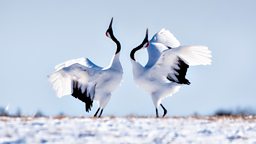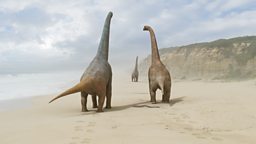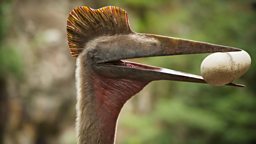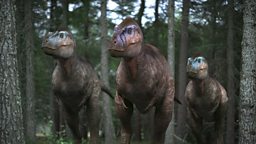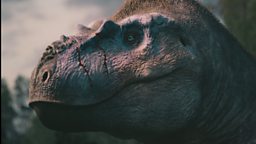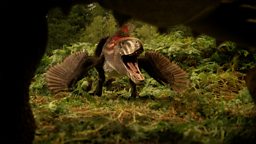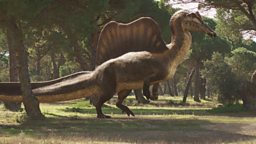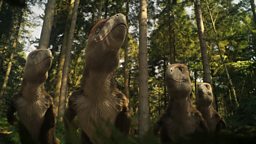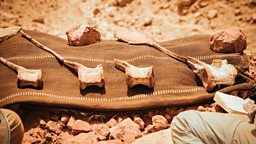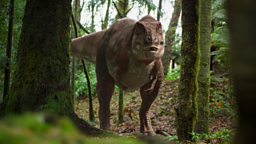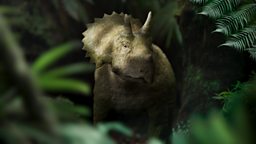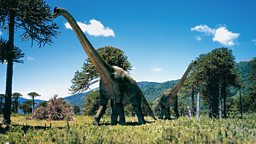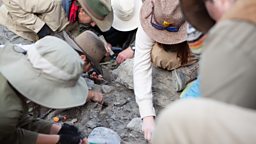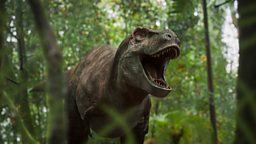Dino dance moves
By Sam Wigfield, series assistant producer
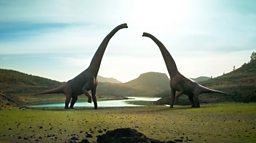
Across the series, we have seen some incredible dinosaur behaviour. From fights pitting titans against each other, to herds of epic proportions gathering for migration, tales of struggle and survival existed just as much in the prehistoric world as they do in today’s natural world. Yet dinosaurs were also capable of joyful moments, and if you know where to look, the clues to this behaviour can also be found buried in the rock itself.
Experts have found evidence of dinosaurs all over the planet throwing some serious shapes
In Island of Giants we show a mind-blowing sequence of the Lusotitan Old Grande pulling out all the stops to shake it for his mate and impress her, but he’s not the only dancing dino out there. Experts have found evidence of dinosaurs all over the planet throwing some serious shapes - here we dive into some of our favourite ‘dance moves’ and the incredible science that they foxtrotted out of!
Dance Move – Kick back and claw!
Footprints left by dinosaurs have been found in every continent. They form slowly, when the ground the dinosaurs stood on turns to rock, keeping the shape of the footprint. Finding multiple in a row is called a trackway and allows scientists to work out the stride length of an animal, and with some clever calculations – their speed. But in very special cases, more than simply the stride length is preserved. In western Colorado, scientists discovered marks in 100-million-year-old sandstone that were clearly made by feet, because they could see individual claw marks, meaning they were made by the predatory theropods (theropods are animals like T. rex and Velociraptor). These footprints were not in a straight line, and scientists quickly ruled out some of the more straightforward explanations as to how they could have been made.
They were not formed by digging for food, as it would be unlikely for carnivorous theropods to dig for roots and tubers, neither were these scrapes made to dig a nest, as the marks looked fresh and a brooding dinosaur near a nest would wear down these marks. Scientists theorised that these marks were created by dinosaurs dancing! In the modern day, birds display behaviour that performatively shows off their ability to build a nest to attract a potential mate, the trackways in western Colorado show evidence for similar behaviour 100 million years ago.
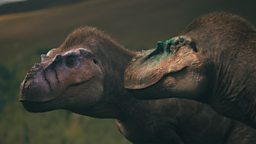
Dance Move – Dancing cheek to cheek
we would never recommend you try to hug a T. rex!
As a dinosaur, footwork may be an important skill to master for dancing, but getting close to your dancing partner may require you to show a more sensitive side than your giant claws and teeth may suggest. For some of the meanest carnivores ever to have lived, scientists found their faces to be full of nerve endings. Research on skulls of predatory dinosaurs, including Neovenator salerii in the UK and the close cousin of T. rex known as Daspletosaurus horneri in Montana, used X-rays to look within the skull itself. Across multiple studies, the canal for nerves connected to the face, known as the trigeminal nerve, was larger than expected and branched into hundreds of nerve endings towards the snout. With similar nerve endings seen in all types of tyrannosaurs, researchers conclude that even the terrifying T. rex could have nerve endings that were sensitive not only to touch, but even to changes in pressure near their face, which would likely be used in courtship rituals and mating displays. So face stroking between T.Rex engaging in social exchanges could release similar endorphins as we get from giving hugs – although we would never recommend you try to hug a T. rex!
Dance move – Get your gladrags on and hit the floor
Across the dinosaur kingdom, there are plenty of eye-catching features that would turn the heads of most. From the fancy frill of a Triceratops to the huge sail of a Spinosaurus or the dazzling display of an Edmontosaurus head crest, these structures are distinctive, but why are they there in the first place? Their size makes them impractically large, so they must have an evolutionary reason for being there, otherwise the dinosaurs would not have them. On the rare occasions when we have juvenile fossils, these features can be absent, suggesting they are grown later in life, so there is a strong chance that many of these features are there to impress a mate. Dinosaurs may have moved in a way to show these structures to each other, combining body parts and movement in a way to intimidate rivals or attract a potential mate.
At the right moment, finding the best way to show off your display was our equivalent of dressing to impress, so find your favourite party outfit and dance like a dinosaur.
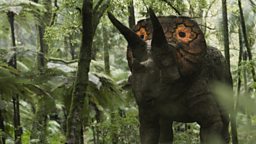
Dance move – Shake your tail feathers
there’s a part of every bird's behaviour that can give some sort of clue to how dinosaurs danced
Fossils are rare and incredibly hard to find, so discovering fossils that might possibly give us clues as to how dinosaurs behaved is even rarer still! But there are some places we can find dinosaurs in the modern day – birds. Birds are direct descendants of a group of theropod dinosaurs that survived the extinction event that marked the end of the Cretaceous. Since then, they have evolved into over ten thousand different species, all with their own quirks and styles, and crucially… dance moves. Dinosaur experts today closely study the behaviour and ‘dance moves’ of modern birds to help imagine how their prehistoric ancestors might have behaved, moved and shaken their own tail feathers!
Whether you like the flamboyance of a peacock, the ingenuity of birds-of-paradise or the bizarreness of a frigatebird's display, there’s a part of every bird's behaviour that can give some sort of clue to how dinosaurs danced, so pick your favourite and take those moves to the nearest dance floor.
So kick up your feet, get a dance partner, put on your best gladrags, shake your tail feathers and if all else fails, copy the dance moves of your favourite bird. To the Dino Disco!
